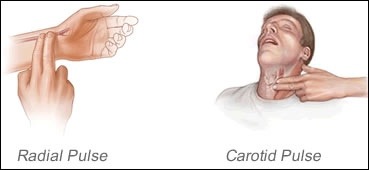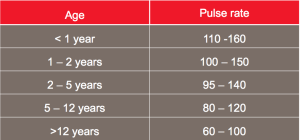Taking a pulse
What is a pulse?
When you heart beats (contracts) it produces a pressure wave. This pressure wave can be detected and counted in order to provide information on the heart rate which is measured in beats per minute (bpm).
To feel (palpate) a pulse it is normally necessary to compress an artery against a bone. This is why a pulse can normally only be felt at specific locations on the body.
Why should I take a pulse?
A pulse can provide important information about the condition of a casualty. Various medical conditions and illnesses can speed up or slow down a persons’s heart rate.
How do I take a pulse?
There are three main places where you can take a pulse:
 1) The radial artery in the wrist
1) The radial artery in the wrist
2) The brachial artery in the elbow crease
3) The carotid artery in the neck
To take a pulse you should use two fingers to compress the artery. It make take some practice before you are able to find pulses quickly and accurately.
After you’ve found the pulse you need to count in order to determine the heart rate in beats per minute. You can either count for a full minute (this is the most accurate method) or count for 30 seconds and multiply by 2.
As well as the number you should also feel for the pulse rhythm – is it regular or irregular? Also take note of the strength of the pulse, is it strong or weak?
The best way to learn how to take a pulse is to practice practice practice! Find your own pulse first, then start practicing on other people (with their permission of course!)
Normal pulse rates
Most adults have a resting heart rate of 60 – 100 beats per minute (bpm). The fitter you are, the lower your resting heart rate is likely to be. For example, athletes may have a resting heart rate of 40 – 60 bpm or lower. Children generally have faster pulse rates
Let’s begin! Click the blue “Next Unit” button below to move on through the course

